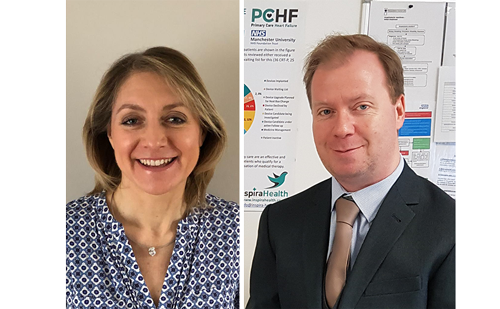The landscape of managing atrial fibrillation (AF), the most common cardiac arrhythmia and leading cause of stroke, has undergone a period of change following the development of various treatment modalities and risk-modifying strategies designed to mitigate the risk of stroke in patients with AF.1,2 In this expert interview, Tony D Grayson and Carol Hughes highlight the role of direct oral anticoagulants (DOACs) in optimizing AF management, their effectiveness in reducing risk of stroke and the benefits they can offer in terms of monitoring. They also examine the gap in patient care that still exists despite the effectiveness of DOACs and discuss the impact of the Primary Care Atrial Fibrillation (PCAF) service, a programme aimed at optimizing anticoagulation therapy in patients with AF. This discussion not only underscores the significance of the PCAF service in optimizing patient care, but also highlights the importance of innovative treatment strategies and continued research in AF management.
Q. Could you provide some background on the relationship between patients with AF and the link to stroke, and the unmet needs in this area?
AF is the most common cardiac arrhythmia and is associated with a five-fold increase in stroke risk. These strokes, which are often fatal or result in severe disability, are a consequence of blood clots, formed due to blood pooling in the heart during AF episodes. These clots can then travel to the brain and cause a stroke.
To mitigate stroke risk, direct oral anticoagulants (DOACs) such as apixaban, dabigatran, edoxaban, or rivaroxaban are used.3 DOACs have been shown to be at least as effective as vitamin K antagonist (VKA) medications in reducing AF-related stroke, with a reduced risk of intracranial haemorrhage and similar bleeding profile.3 In addition, DOACs offer consistent anticoagulant effects with fewer drug interactions and thus do not require monitoring of their anticoagulant effect, therefore reducing the need for regular blood testing.
Despite the range of anticoagulants available for use in patients with AF, the National Institute for Health and Care Excellence (NICE) estimate that up to 45% of patients who should be anticoagulated are not.4
The NHS Long Term Plan emphasizes the importance of anticoagulation, stating that their use can avert approximately four strokes in every 100 patients with AF, thus preventing serious disability or even death.5
Q. What are the benefits and risks of anticoagulation in patients with AF?
Anticoagulants significantly reduce the of risk of AF-related stroke by preventing blood clots. This in turn lowers the risk of death following a stroke or the risk of life-long disability.6
DOACs in particular have a number of benefits when compared with VKA medication. Generally, DOACs are safer and more effective than warfarin, particularly in serious bleeding incidents, causing half as much life-threatening bleeding than warfarin.7 They require less monitoring, can be given safely in fixed doses and have fewer interactions with other medications and food.8 However, patients can experience side effects while taking anticoagulants, such as increased risk of bleeding, passing blood in urine, easier bruising and prolonged bleeding from cuts.9
However, any risk of bleeding always needs to be weighed up against the risk of a life-threatening or seriously debilitating stroke. Clinicians globally use risk stratification tools to aid in this clinical judgement. CHA2DS2-VASc is a tool used for stroke risk assessment and ORBIT is a tool used to assess the risk of bleeding.10
Q. What are the aims, design and eligibility criteria of the programme you are running?
Inspira Health’s Primary Care Atrial Fibrillation (PCAF) national service aims to ensure that patients with AF are appropriately anticoagulated, with the primary goal of reducing AF-related strokes.11
Primary care networks (PCNs) received invitations from NHS England to apply for funding for the PCAF service. Eligibility criteria for PCNs included being in the top two national quartiles for (i) diagnosed, but untreated AF or (ii) estimated undiagnosed patients with AF; utilizing the Quality Outcomes Framework; and Public Health England data.12
The following approach was used for participating PCNs:12
-
Step 1: Creation of patient lists from AF registers
-
Step 2: A comprehensive clinical audit of patients with AF who were not anticoagulated, or who are either currently prescribed warfarin or DOACs
-
Step 3: A systematic patient invitation for telephone consultations
-
Step 4: Specialist-led telephone clinics to optimize anticoagulation therapy
-
Step 5: Follow-up review
Q. What were the key findings and outcomes of this programme and, in your opinion, what are the clinical implications?
Eighty-five PCNs participated, consisting of 351 general practice clinics covering a population of 4,071,353 between October 2022 and September 2023. AF prevalence was 2.9% (n=117,371). Among these patients with AF, 103,514 (88.2%) were already on anticoagulant medication, 12,533 (12.1%) were recieving warfarin and 90,981 (87.9%) were receiving DOACs.12
Medical records were reviewed for 13,857 patients who were not on anticoagulation, with 11,085 (80%) patients deemed not eligible for anticoagulation. This left 2,772 (20%) patients who were eligible for, but not on, anticoagulation. Additionally, 1,712 (13.7%) of the patients being treated with warfarin showed a suboptimal international normalized ratio (INR) control with transthyretin (TTR) <65%. Among the patients receiving a DOAC, 3,932 (4.3%) required a dosage review and 44,035 (48.4%) were eligible for DOAC optimization in line with NHS England guidelines.12
In total, 52,451 patients were reviewed by a healthcare professional, resulting in new prescriptions, changes to existing anticoagulant treatments or DOAC dose adjustments. Of these, 8,416 patients had a medication intervention, which would reduce their risk of AF-related stroke, potentially preventing 337 strokes, saving 200 lives and achieving a cost saving, through reduced stroke admissions, of £8,079,715.12,13 A further cost saving of £13,210,572 per year was achieved with a reduction in medicine management budgets as per NHS England guidelines.13
In total, so far, the programme has achieved a total cost saving to NHS budgets of £21 million. In addition, the programme has received a satisfaction rating of 98.4%, based on patient feedback.
Q. Do you have any plans for further research in this area or suggestions for future work that could be done?
The UK has an excellent and growing network of healthcare professionals working on innovative solutions to address AF anticoagulation and reduce the risk of AF-related stroke. Credit for this achievement largely goes to the tremendous efforts of the AF Association and Trudie Lobban, Founder & Trustee of Arrhythmia Alliance, UK.
Inspira Health will continue to support these efforts, whilst also working to address other cardiovascular-related conditions and supporting the NHS to optimize patient care.
The future of anticoagulation management looks bright. The development of new medications, such as Factor XIa inhibitors, have the potential to prevent thromboembolic events with a lower risk of bleeding compared with current treatment options, making this treatment an option for patients who until now were not eligible to recieve an anticoagulant.14







